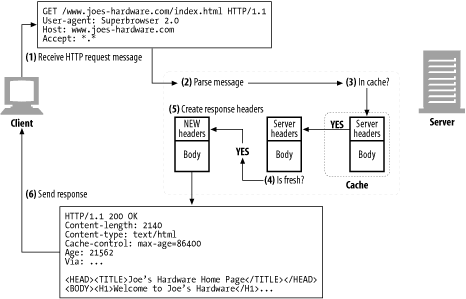Cache Processing Steps
Modern commercial proxy caches are quite complicated. They are built to be very high-performance and to support advanced features of HTTP and other technologies. But, despite some subtle details, the basic workings of a web cache are mostly simple. A basic cache-processing sequence for an HTTP GET message consists of seven steps (illustrated in Figure 7-11):
Receiving—Cache reads the arriving request message from the network.
Parsing—Cache parses the message, extracting the URL and headers.
Lookup—Cache checks if a local copy is available and, if not, fetches a copy (and stores it locally).
Freshness check—Cache checks if cached copy is fresh enough and, if not, asks server for any updates.
Response creation—Cache makes a response message with the new headers and cached body.
Sending—Cache sends the response back to the client over the network.
Logging—Optionally, cache creates a log file entry describing the transaction.

Figure 7-11. Processing a fresh cache hit
Step 1: Receiving
In Step 1, the cache detects activity on a network connection and reads the incoming data. High-performance caches read data simultaneously from multiple incoming connections and begin processing the transaction before the entire message has arrived.
Step 2: Parsing
Next, the cache parses the request message into pieces and places the header parts in easy-to-manipulate data structures. ...
Get HTTP: The Definitive Guide now with the O’Reilly learning platform.
O’Reilly members experience books, live events, courses curated by job role, and more from O’Reilly and nearly 200 top publishers.

